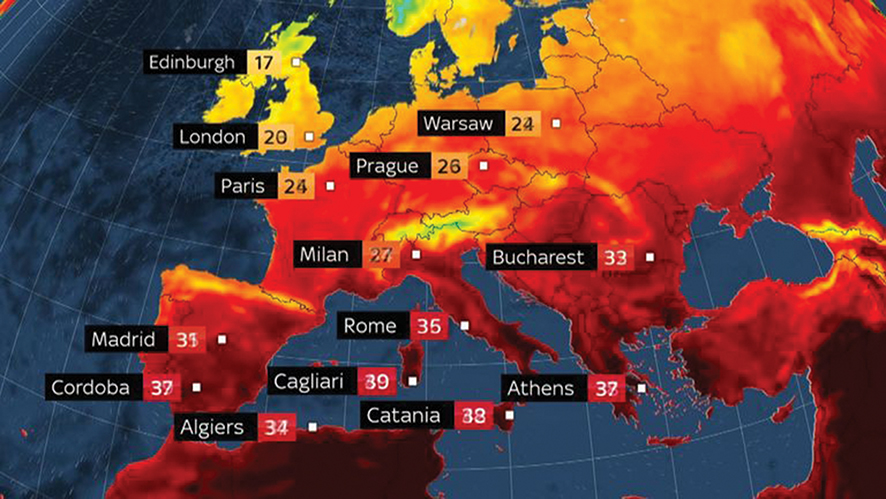1. Introduction: Understanding the European Heatwave of 2025 and Its Impact on Public Health
As global temperatures continue to rise, the effects of extreme heatwaves are becoming more pronounced. In 2025, Europe experienced a record-breaking heatwave that resulted in a significant increase in heat-related deaths and drownings. With climate change exacerbating these extreme weather events, it is more important than ever to understand the implications of heatwaves on public health and safety. This article delves into the alarming rise in heat-related deaths and drownings during the European heatwave of 2025 and explores potential strategies to mitigate the impacts of future extreme weather events.
2. Overview of Heat-Related Deaths and Drownings During the 2025 Heatwave
During the 2025 European heatwave, the surge in temperatures led to a staggering rise in heat-related deaths and drownings across the continent. The elderly and vulnerable populations were particularly at risk, underlining the urgent need for proactive measures to protect public health during extreme weather events. Understanding the specific circumstances and locations where these tragedies occurred can provide valuable insights for enhancing early warning systems and emergency response protocols in the future. Stay tuned as we delve deeper into the trends and implications of these alarming statistics in our upcoming sections.
3. Analyzing the Causes of Rising Temperatures and Extreme Weather Patterns in Europe
The alarming spike in heat-related deaths and drownings during the 2025 European heatwave underscores the pressing need to delve into the root causes of rising temperatures and extreme weather patterns in Europe. Climate change, urbanization, and infrastructure vulnerabilities are among the key factors exacerbating the impact of heatwaves on public health. By examining these causes in-depth, we can better understand how to adapt and mitigate the risks posed by extreme weather events. Stay informed as we explore the interconnected factors driving the escalating heat-related dangers in Europe in our upcoming blog sections.
4. Vulnerable Populations: Who Is Most Affected by Heatwaves and Drownings?
As we continue our exploration of the 2025 European heatwave crisis, it is crucial to identify the vulnerable populations disproportionately affected by heat-related incidents and drownings. Elderly individuals, children, pregnant women, lower-income communities, and individuals with pre-existing health conditions are particularly at risk during extreme heat events. Understanding the specific vulnerabilities of these groups can aid in the development of targeted interventions and strategies to protect and support those most in need. Join us in our upcoming blog section as we delve into the factors contributing to the heightened vulnerability of these populations in the face of escalating heatwave challenges.
5. Effective Strategies for Mitigating Heat-Related Risks and Enhancing Public Safety
In the face of the escalating European heatwave crisis, implementing effective strategies is critical to safeguard vulnerable populations and enhance public safety. Heat action plans, early warning systems, cooling centers, hydration stations, and community outreach programs play a vital role in mitigating heat-related risks. Collaborative efforts between government agencies, healthcare providers, community organizations, and citizens are essential for creating resilient and adaptive responses to extreme heat events. Stay tuned as we delve into these strategies in our next blog post and explore how collective actions can make a significant difference in preventing heat-related fatalities and ensuring the well-being of all individuals during heatwaves.
6. Role of Government and Health Organizations in Addressing Heatwave Challenges
Government and health organizations are at the forefront of addressing the challenges posed by the European heatwave crisis. Their responsibilities include funding and implementing heat action plans, enhancing early warning systems, and coordinating with local authorities to establish cooling centers and hydration stations. Additionally, health organizations play a crucial role in providing medical support, raising awareness about heat-related illnesses, and conducting outreach programs to educate the public. By working together and pooling resources, these entities can effectively tackle the impacts of heatwaves and protect the well-being of individuals across the region. Stay informed on the indispensable roles these organizations play in our next blog post.
7. Conclusion: Preparing for Future Heatwaves and Protecting Lives in Europe
As the European heatwave crisis intensifies, it is imperative for all stakeholders to prioritize proactive measures to safeguard vulnerable populations. Government agencies, health organizations, and citizens must collaborate on long-term strategies to mitigate the impacts of rising temperatures. This includes investing in sustainable infrastructure, implementing stringent heat action plans, and promoting community resilience through education and outreach programs. By fostering a culture of preparedness and vigilance, we can effectively reduce the devastating effects of heatwaves and ensure the safety and well-being of all individuals in Europe. Stay engaged and informed as we continue to explore vital initiatives to combat the challenges posed by extreme heat events in our upcoming blog posts.





0 Comments